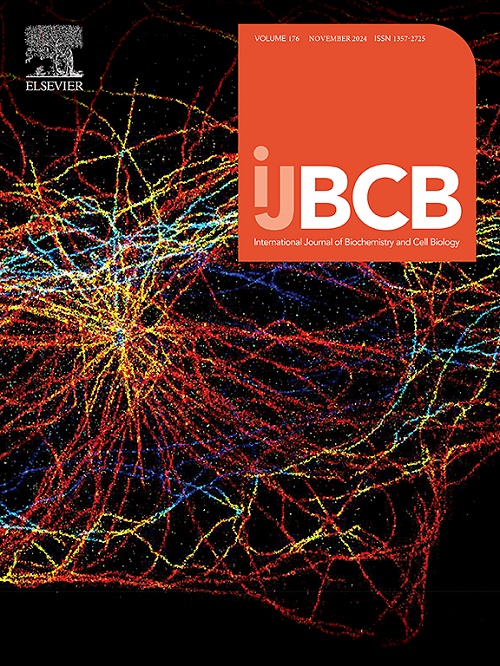Clostridium butyricum protects the ileal barrier in mice by regulating the farnesoid X receptor signaling pathway
IF 2.8
3区 生物学
Q2 BIOCHEMISTRY & MOLECULAR BIOLOGY
International Journal of Biochemistry & Cell Biology
Pub Date : 2025-05-19
DOI:10.1016/j.biocel.2025.106798
引用次数: 0
Abstract
Background
The intestinal barrier has an important role in maintaining homeostasis. The aim of this study was to determine the protective effect of Clostridium butyricum (CBM) on small intestinal barrier damage in mice and the role of farnesoid X receptor (FXR) in regulating the intestinal barrier by C. butyricum.
Methods and results
A model of small intestinal injury induced by dextran sulfate sodium (DSS) was constructed to detect repair of intestinal barrier damage after feeding with C. butyricum. In the DSS model group, expression of the tight junction protein (TJP) was significantly decreased and expression of inflammatory factors was significantly increased. TJP expression was significantly increased and inflammatory factor expression was significantly decreased after C. butyricum feeding, which indicated that intestinal barrier function was repaired. In addition, inhibition of FXR expression as well as the downstream signaling pathways were demonstrated in the DSS model group. FXR and its downstream signaling pathways were significantly upregulated after feeding with C. butyricum. Then, intestinal barrier function was evaluated by constructing an intestinal-specific FXR knockout (KO) DSS model in mice. Suppression of TJP and upregulated expression of inflammatory factors were detected in the KO DSS group but there was no significant difference in the expression of TJP and inflammatory factors after C. butyricum feeding. Furthermore, there was no significant difference in FXR downstream signaling pathway expression after C. butyricum feeding compared to the KO DSS group. C. butyricum supernatants (CSs) upregulated the FXR signaling pathways in vitro. CSs did not activate the FXR signaling pathway when FXR was suppressed.
Conclusions
C. butyricum supplementation effectively ameliorated DSS-induced intestinal barrier disruption. C. butyricum may have a protective effect on the small intestine through the FXR signaling pathway.
丁酸梭菌通过调节farnesoid X受体信号通路保护小鼠回肠屏障。
背景:肠道屏障在维持体内平衡中起着重要作用。本研究旨在探讨丁酸梭菌(Clostridium butyricum, CBM)对小鼠小肠屏障损伤的保护作用及法内脂X受体(farnesoid X receptor, FXR)在丁酸梭菌调节小肠屏障中的作用。方法与结果:建立硫酸葡聚糖钠(DSS)致小肠损伤模型,观察丁酸梭菌饲喂后小肠屏障损伤的修复情况。DSS模型组大鼠紧密连接蛋白(TJP)表达明显降低,炎性因子表达明显升高。饲喂丁酸梭菌后,TJP表达显著升高,炎症因子表达显著降低,表明肠道屏障功能得到修复。此外,在DSS模型组中,FXR的表达以及下游信号通路均受到抑制。饲喂丁酸梭菌后,FXR及其下游信号通路显著上调。然后,通过构建小鼠肠道特异性FXR敲除(KO) DSS模型来评估肠道屏障功能。KO DSS组TJP表达受到抑制,炎症因子表达上调,但饲喂丁酸梭菌后TJP和炎症因子表达无显著差异。此外,与KO DSS组相比,丁酸梭菌饲喂后FXR下游信号通路的表达无显著差异。C. butyricum上清液(CSs)上调FXR信号通路。当FXR被抑制时,CSs不激活FXR信号通路。结论:补充丁酸梭菌可有效改善dss引起的肠屏障破坏。丁酸梭菌可能通过FXR信号通路对小肠产生保护作用。
本文章由计算机程序翻译,如有差异,请以英文原文为准。
求助全文
约1分钟内获得全文
求助全文
来源期刊
CiteScore
8.10
自引率
0.00%
发文量
124
审稿时长
19 days
期刊介绍:
IJBCB publishes original research articles, invited reviews and in-focus articles in all areas of cell and molecular biology and biomedical research.
Topics of interest include, but are not limited to:
-Mechanistic studies of cells, cell organelles, sub-cellular molecular pathways and metabolism
-Novel insights into disease pathogenesis
-Nanotechnology with implication to biological and medical processes
-Genomics and bioinformatics

 求助内容:
求助内容: 应助结果提醒方式:
应助结果提醒方式:


